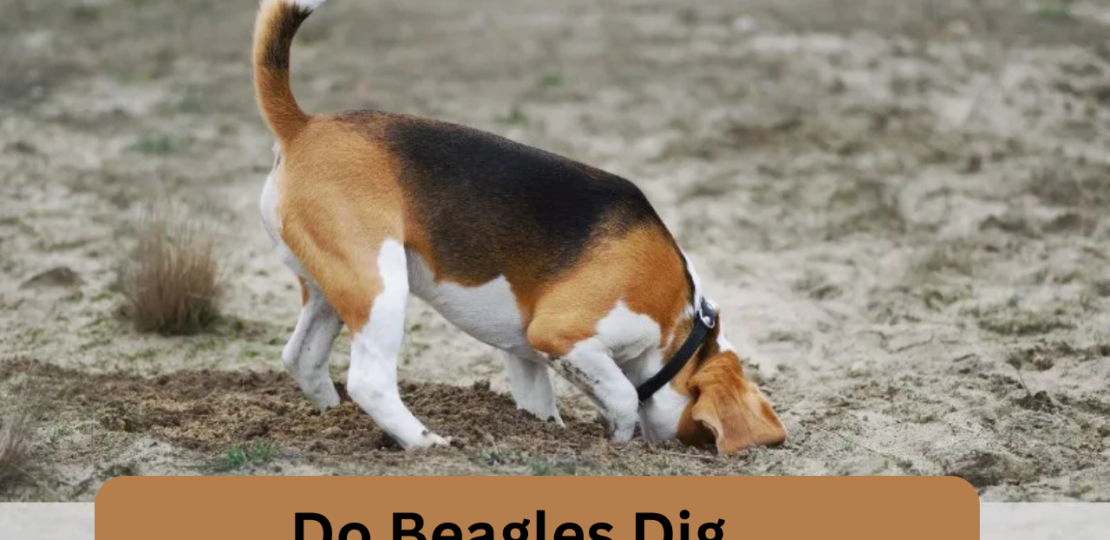Do Beagles Dig? Understanding Beagle Behavior and Instincts
February 2, 2025 | by mrafk.84@gmail.com

Beagles are one of the most beloved dog breeds, known for their affectionate nature, keen sense of smell, and lively demeanor. However, like many other dog breeds, Beagles come with their own set of instincts and behaviors, one of which is digging. So, do Beagles dig? The answer is yes—Beagles often dig, and it’s important to understand why and how to manage this behavior to ensure your Beagle is happy and well-adjusted.
Typical Beagle Behavior and Instincts
Beagles were originally bred as hunting dogs, particularly for tracking small game like rabbits and hares. As scent hounds, they have an extraordinary sense of smell and an instinctive drive to track scents. This hunting instinct can sometimes manifest in behaviors like digging, as they may dig in an attempt to uncover prey or trace the scent they’re following. Understanding these natural instincts is key to managing your Beagle’s behavior and reducing unwanted digging.
Beagles are also known for their playful and social nature. They thrive on interaction with their human families and other dogs. This sociable temperament means that Beagles can become quite attached to their owners, and when they feel bored, stressed, or anxious, they may engage in digging as a coping mechanism.
Understanding Digging Habits

Digging in Beagles isn’t necessarily a sign of disobedience. For many Beagles, it is rooted in their instincts, emotions, or the environment they’re in. Digging can be a normal behavior that should be understood, especially when it’s done in specific situations.
One of the most common reasons Beagles dig is out of curiosity. Beagles are naturally inquisitive, and their sense of smell drives them to explore every nook and cranny. If they detect a scent, their first instinct may be to dig to investigate further. This behavior can be exacerbated when they’re outside and their nose leads them to dig beneath the soil, around rocks, or even under fences in an attempt to uncover something they sense but cannot see.
Do Beagles Dig? Common Reasons for Digging
1. Hunting and Scent Tracking
Beagles are famous for their hunting instincts, and they often dig to follow a scent trail. Since their sense of smell is 20-40 times stronger than that of humans, they are constantly tracking new scents in their environment. When a Beagle detects something they want to follow, they might dig in an attempt to “uncover” whatever has left that scent, which can sometimes result in digging under fences, plants, or the ground itself.
2. Boredom
Beagles are an active and energetic breed. When they don’t have enough physical or mental stimulation, they may engage in behaviors like digging as a form of entertainment. Digging can be an outlet for excess energy or a way for a Beagle to entertain themselves when left alone.
3. Comfort and Temperature Regulation
Sometimes, digging is simply an attempt to create a comfortable space. Beagles may dig to create a cooler, more comfortable spot, especially when the ground is hot, or during the warmer months. They might dig in bedding, in the dirt, or even in their favorite resting spots to create a cooler, softer space to relax.
4. Escape or Exploration
If a Beagle feels confined or restricted, they may dig to escape. Whether it’s a fence, a crate, or an enclosed area, digging could be an attempt to break free and explore the world outside. This is particularly common with Beagles, as their curiosity often outweighs their need for safety.
The Impact of Separation Anxiety
One of the more challenging behaviors that can lead to digging is separation anxiety. Beagles are extremely social dogs and can become very attached to their families. When left alone, a Beagle may feel anxious, stressed, or even frightened. To alleviate this anxiety, they may resort to digging, barking, or other destructive behaviors. Digging, in this case, becomes a way for them to deal with their discomfort, especially if they feel isolated or abandoned.
Creating a Safe Environment for Your Beagle
To reduce and manage digging, it’s important to ensure that your Beagle feels safe, secure, and stimulated. Creating a safe environment can prevent unnecessary digging and help your Beagle feel more comfortable and less anxious.
1. Establishing a Safe and Secure Yard
Beagles are known to dig under fences, especially when they feel the urge to escape or explore. To prevent this, you can reinforce your yard by adding barriers like chicken wire or burying fencing materials a few inches into the ground. This makes it much harder for your Beagle to dig their way out. Additionally, make sure that your fence is tall enough to prevent jumping.
2. Creating a Designated Digging Area
One way to redirect a Beagle’s digging behavior is to designate a specific area where digging is allowed. You can create a digging pit by filling an area with sand or loose dirt. When your Beagle digs in this area, reward them with praise or treats. This can help them associate digging with positive reinforcement, and they may begin to focus their digging urges on this area rather than elsewhere in the yard.
Importance of a Safe Place
A designated safe place for your Beagle, like a crate or a cozy bed, can also play a significant role in reducing digging. Beagles, like many dogs, dig to create a comfortable space. Providing them with a safe, comfortable, and secure resting place can discourage them from digging elsewhere in the house or yard. It also helps with training your Beagle to settle down when indoors, preventing anxiety-driven digging.
Designing a Beagle-Friendly Yard
A Beagle-friendly yard is one that is both safe and stimulating. To minimize digging, make sure your Beagle has enough physical and mental stimulation. You can add features to the yard such as tunnels, platforms, and even scent trails that will encourage exploration in a controlled way. Additionally, ensuring that your Beagle has a shaded spot to relax on warm days will help keep them from digging to regulate their temperature.
Exercise and Mental Stimulation
Regular exercise is essential for Beagles, as they have high energy levels and need both physical and mental stimulation to stay healthy and happy. Without adequate exercise, your Beagle may turn to digging to release excess energy or boredom. Daily walks, runs, and playtime in the yard can keep them physically fit and mentally engaged, reducing the need for undesirable behaviors like digging.
Benefits of Regular Exercise
Regular physical activity provides Beagles with the opportunity to burn off excess energy. Whether it’s a brisk walk, a game of fetch, or a trip to the dog park, regular exercise helps to release pent-up energy and prevents destructive behaviors like digging.
Mental Exercises as a Digging Deterrent
In addition to physical exercise, Beagles need mental stimulation. Puzzle toys, scent games, and interactive play can keep your Beagle’s mind engaged and satisfied. Training them to follow commands or to complete scent-based tasks can help focus their instincts on productive activities, rather than digging.
Training and Positive Reinforcement
Training is a crucial part of managing your Beagle’s behavior, including digging. It’s important to start training at an early age to help your Beagle understand what is expected of them and what is not allowed.
Starting Training at an Early Age
Beagles are intelligent dogs that respond well to training when it is done consistently and positively. By starting training early, you can teach your Beagle commands such as “no dig” or “come,” which will help in redirecting unwanted behaviors. Positive reinforcement is the key to success—reward your Beagle with treats, praise, and playtime when they exhibit the behavior you want to encourage.
Rewarding Good Behavior
Rewarding your Beagle for digging in the right places or refraining from digging altogether can help reinforce positive behaviors. Consistently using positive reinforcement will help your Beagle understand which behaviors are acceptable and which are not, making it more likely that they will repeat the good behaviors.
What’s Next?
Managing digging in Beagles is possible with the right combination of understanding, training, and environment management. By recognizing the underlying reasons for digging—whether it’s instinct, boredom, or anxiety—you can take proactive steps to redirect your Beagle’s behavior. Providing a secure environment, mental and physical stimulation, and consistent training will not only reduce digging but also help your Beagle lead a happier, healthier, and more balanced life.
If you notice your Beagle digging excessively or in situations where they seem stressed or anxious, consulting with a veterinarian or professional dog trainer may be helpful. With patience and persistence, you can ensure that your Beagle grows up as a well-behaved, happy companion.
RELATED POSTS
View all



